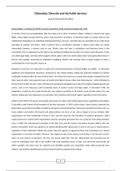Citizenship, Diveessiyi ande yhe Publiii Sesveiies
Legal and Humanitarian Rights
Human Rights - Including the UDHR, Geneva Conventon, ECHR, and Human Rights Act 1998
In society, there are key legalisatons that have been put in place to protect citiens; defned as Human and Legal
Rights. These rights promote diversity, peace, and security for all citiens. To introduce rights as a whole; they are the
enttlements belonging to an individual outlining what they can have, and what they are permited to do, under basic
principles of equality and justce. Many countries have a consttuton whereby a citiens basic rights are clearly
transcribed; however, a country such as ours, Britain, does not have a consttuton and therefore there is the
assumpton that an individual has the right to do anything providing the law does not clearly state otherwise. These
are called legal rights, and they ofen support human rights; which are moral rights based upon generalised ideas of
fairness and equality, protectng an individual’s wellbeing, beliefs, and ensuring them enough freedom to lead a
comfortable life in the way they choose to.
Relatng to all of this, it is important to regard the Universal Declaraton of Human Rights (or UDHR)s - an extremely
signifcant and fundamental document, produced by the United Natons statng the expected standard of conduct
worldwide; produced afer the Second World War. The tmely document was created afer people considered the fact
there must be other, more peaceful ways to handle internatonal issues rather than declaring war - while refectng on
the fact that in under 30 years, there had been two world wars alongside many other horrendous happenings and war
crimes, such as the holocaust, which breached many of today’s human and legal rights. In December 1948, the
declaraton, created by the newly formed UN, was agreed; consistng of 30 artcles (some broken down into sub-
artcles)s statng just how important it is to provide every individual with human rights, regardless of their diversites.
Similar to the UDHR, the Geneva Conventon documents are other internatonal agreements regarding Human Rights.
To provide a brief history of the formaton of the frst document, in 1859 a Swiss citien, Henry Dunant, observed the
destructon caused afer the Batle of Solferino during the Second World War. He became horrifed that there were so
many soldiers and citiens lef injured and dying without any form of aid, and so began to set up medical relief
organisatons for those individuals in tmes of war. He also stood for the formaton of another agreement, which
would protect the medical relief organisatons and the wounded personnel they are caring for from being atacked.
Soon, in 1864, the Internatonal Commitee of the Red Cross and the Geneva Conventon became ofcial, afer the
Geneva Conventon treaty was signed by 12 natons declaring their agreement to care for any sick or injured person,
regardless of their natonality. Within the treaty, they also agreed to regard the Red Cross Commitee as a neutral
organisaton in any kind of confict. However, this original version of the Geneva Conventon is not the only version;
there are four Geneva conventons. The frst and second state that: The sick, shipwrecked and wounded must be
cared for adequately, each side of any confict must treat wounded enemy as their own personnel and provide aid
where possible, the dead must be collected and identfed quickly and respectully while being protected from
robbery, and medical establishments and personnel should be protected from atack.
1




